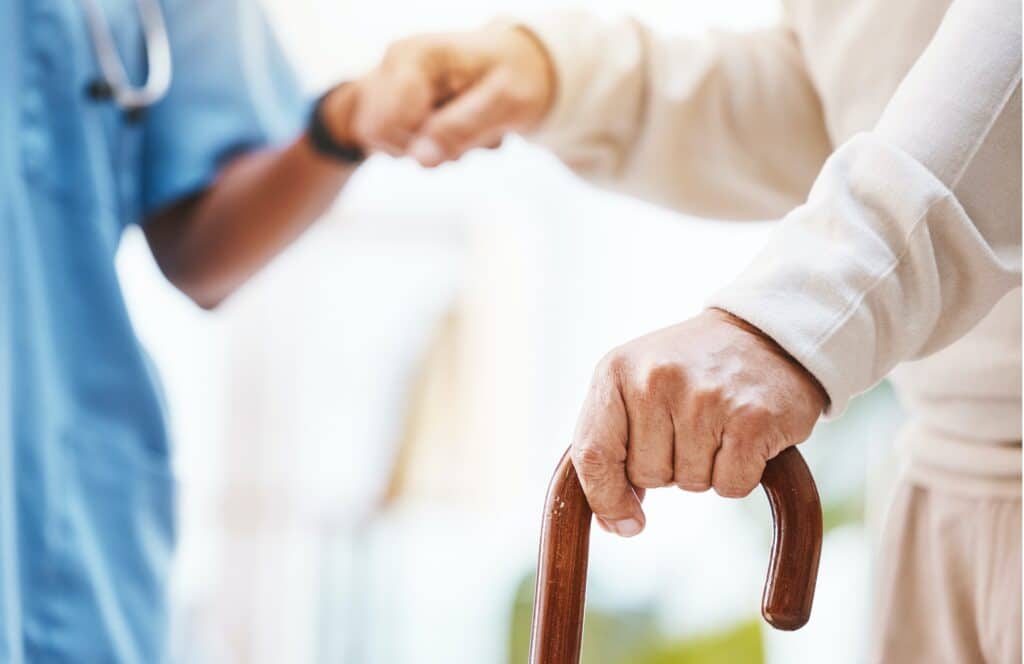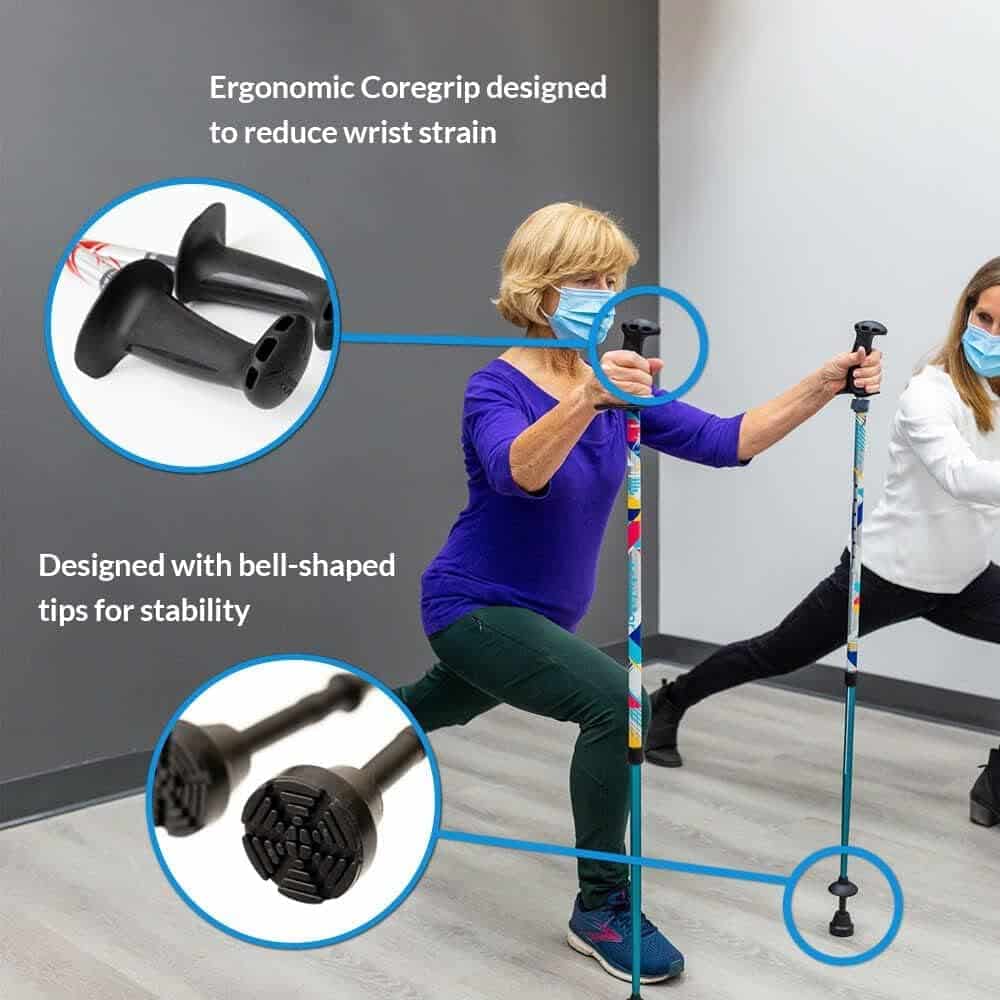Managing Parkinson’s disease can feel overwhelming without proper guidance. However, physical therapy for Parkinson’s Disease offers a highly effective way to mitigate symptoms and enhance your quality of life.
In this article, we’ll explore how individualized exercise programs can significantly improve mobility, strength, and overall well-being for people with Parkinson’s.
Discover the different types of therapy and exercises that can help you stay active and healthy on your Parkinson’s journey.
What Are the Effects of Parkinson’s Disease?
Parkinson’s disease is a neurodegenerative condition that damages the cells in the brain responsible for creating dopamine.
With a loss of dopamine, nerves have a more difficult time communicating, which results in unwanted movement patterns like tremors or difficulty initiating movements, including speech.1
As Parkinson’s Disease progresses, you may experience symptoms such as slowed, smaller movements, stiffness, walking changes, and balance problems. Fortunately, physical therapy can hugely benefit those with Parkinson’s Disease.
How can Physical Therapy Help?
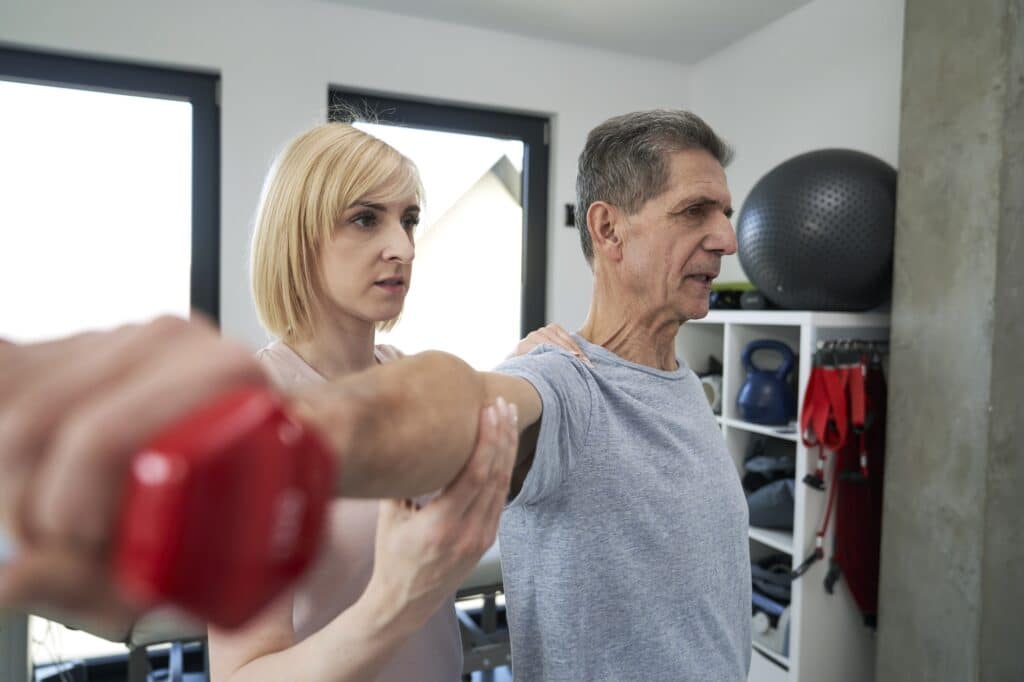
Physical therapists are trained medical professionals specializing in movement and movement disorders.
Physical therapy is based on your individual needs and abilities. Unlike group-based classes, a physical therapist will design a program specific to your needs while ensuring your exercise safety.
Physical therapy for Parkinson’s disease has been widely studied, creating clinical practice guidelines (CPGs) to help therapists make informed, research-based decisions regarding the best possible care practices.2
Research best supports moderate to high-intensity aerobic exercise, resistance training, balance training, gait training, and task-specific training. Community-based activity is also highly recommended.
As a unique attribute specific to Parkinson’s treatment, your physical therapist may also recommend cognitive challenges and specific exercises that focus on the amplitude—or size of movements.2
What To Expect From Your Physical Therapy Exercise Program
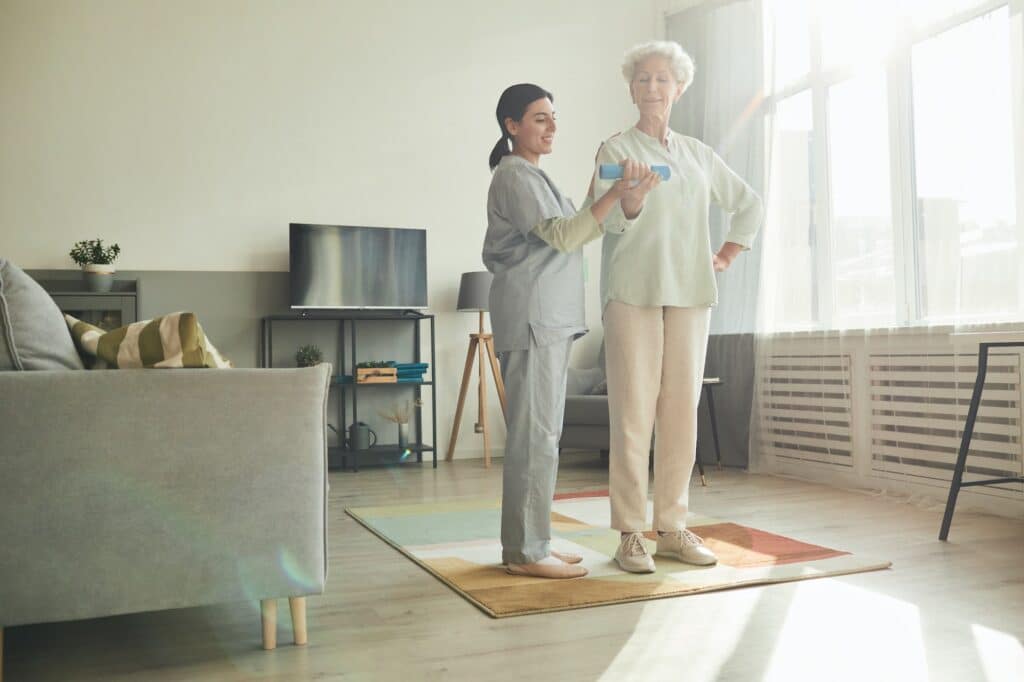
Embarking on a physical therapy exercise program for Parkinson’s Disease can significantly improve your motor function, balance, strength, and overall quality of life.
This program might include aerobic training to boost your heart rate, amplitude training like LSVT-BIG to enhance movement, resistance exercises to build muscle strength and balance training to improve stability.
These targeted exercises help you move better, feel stronger, and live healthier, making a real difference in your daily life. Let’s take a closer look.
Aerobic Training
Aerobic exercise (cardio or cardiovascular exercise) is any exercise that increases your heart rate and helps your body use oxygen more efficiently.
Walking on a treadmill or biking are common examples. However, sustained aerobic exercises (such as step-ups) can also achieve the same effects.
Many studies have demonstrated reduced motor decline and improved walking performance following aerobic training in people with Parkinson’s Disease, while others have reported improved balance, ease of daily living tasks, cognition, sleep, and a lower prevalence of depression, which can be common in some Parkinson’s patients.
The American Physical Therapy Association recommends moderate-to-high aerobic intensity levels defined as 60-75% of your maximum heart rate for moderate and 75-85% for high intensity. Your physical therapist can help you to determine the proper range for your body.2
Amplitude Training
Amplitude training is a central focus point of physical therapy for Parkinson’s Disease.
LSVT-BIG (The Lee Silverman Voice Treatment) is a specialized program that explicitly addresses amplitude of motion using large body movements to improve speed and reduce hesitations in movement.
This program requires specific training and is administered by a certified physical therapist.
After only four weeks of training, the program has improved motor performance and overall quality of life in patients. More significant improvements have been seen with more prolonged treatment periods.3
The LSVT-BIG program is designed to be an individualized approach that addresses motor symptoms and the emotional and cognitive challenges faced by people with PD. To find a certified provider near you, visit lsvtglobal.com.4
Resistance Training
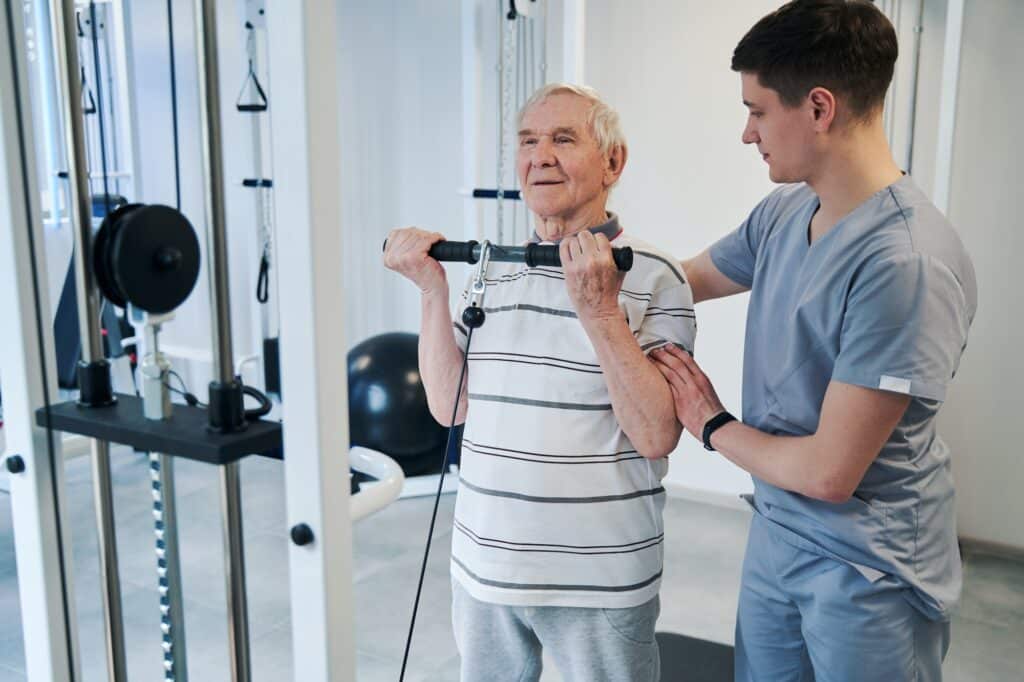
Physical therapist-guided resistance exercises build muscle strength through body weight, bands, weights, or other devices.
High-quality resistance training is progressive, meaning each session gradually increases intensity so your body can continually adapt and grow. Focusing on functional movements like squatting, lifting, lunging, and pulling during training sessions improves strength for daily tasks.
Resistance training has been found to improve strength and power in people generally. However, it can be specifically beneficial for people with Parkinson’s.
Even more significant improvements have been documented when combining resistance training with instability, like standing on a foam pad during training.
Studies have also shown improvements in depression, anxiety, cognition, and quality of life following resistance training.2
Balance Training
Balance training may include various activities, from static (standing still) to dynamic movements, like stepping over an obstacle.
Since Parkinson’s Disease affects your motor patterns and movement planning, you may be at higher risk of falls. For this reason, balance training is typically a crucial part of physical therapy.
Balance exercises will precisely simulate real-life challenges. For this reason, activities may include weight shifting in varied positions and, in some cases, perturbation training which involves being bumped or moved to test your response and stability.2
Balance training can help reduce the risk of falls, improve confidence while moving, and improve walking ability, regardless of a Parkinson’s disease diagnosis.
Using Poles for Stability During Exercise
Many of our Parkinson’s patients like to use walking poles for added security during exercise. The type of poles you use definitely makes a difference. Urban Poling ACTIVATOR Poles are our #1 recommendation. Urban Poling ACTIVATOR Poles were designed by an occupational therapist & gerontologist specifically for rehab and long-term conditions. The smart design enhances strengthening, stability and off-loading with your safety in mind. These are the right support tool while challenging yourself through a Parkinson’s exercise program.
Our recommendations are the same items we trust and prescribe to patients. When you buy through links like this on our site, we may earn an affiliate commission to support new content.
Task-Specific Training and Gait Training
Task-specific training refers to training the exact movement or activity you are trying to improve.
This type of training is all about being specific. For example, if you want to improve your ability to stand from a chair without using your hands, you must practice standing from a chair without using your hands.
Just like an athlete, training in specific, repetitive ways helps to improve the carryover of the activity from the clinic to your daily life and activities. Repetition is a critical factor in the success of this type of training, ensuring that the motor pattern being taught or practiced becomes a habit.
Gait training is one form of task-specific training to improve walking ability. Gait training has been found to help reduce motor disease severity and improve speed, balance, and stride length.2
It is common for your physical therapist to include external cues during training to help build valuable skills. Guided gait training may consist of treadmill walking at certain speeds, walking to the beat of a metronome, walking on varied surfaces, and many other methods based on your specific difficulties.
This method can also be used at home to train and improve daily movement patterns.5
Cognitive Training
Cognitive challenges during exercise require increased mental focus and are typically associated with learning a new skill.
Dual-task training is a prevalent way to combine both task-specific training and cognitive challenges. This method typically requires the completion of one physical activity while simultaneously performing mental challenges.
This might look like walking while counting by threes or naming states. The goal of dual-tasking is to try to maintain proper mechanics and balance while also focusing your attention on mental challenges.2
Skill-based activities are goal- and accuracy-oriented and have been shown to increase the number of synapses per neuron in the motor area of the brain, leading to more significant improvements in brain function in PD patients.6
Group-Based Exercises
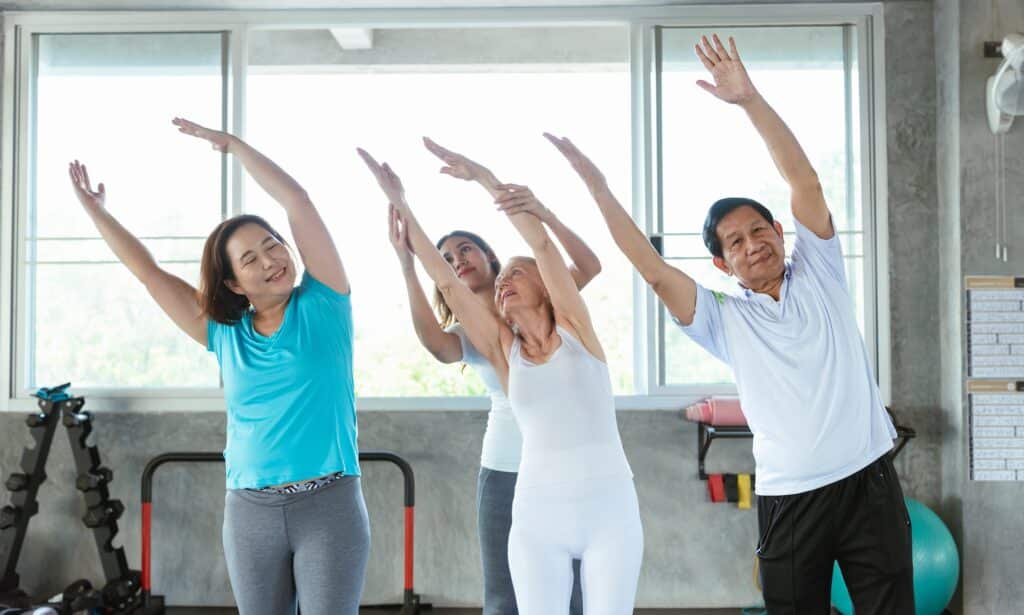
Group-based exercises are highly supported in the research to stay active and incorporate the categories mentioned above.
Classes might range from sport specific, such as boxing, golf, and karate, to balanced-based classes, like yoga and tai chi. Talk with your PT about which resources and classes are available in your area and which may be most beneficial for you.
Finding the Right Approach
An adequately chosen exercise program is your first defense against Parkinson’s disease symptoms.
You can look to your physical therapist as your partner in minimizing the effects of Parkinson’s disease on your daily life. They will build a program with various treatment methods to ensure you get the best care to meet your needs.
Click this link if you’d like to try PWR Moves, a Parkinson’s-based training method.
Key Takeaways
- Parkinson’s disease can be overwhelming, but personalized exercise programs are crucial in managing symptoms and improving quality of life. Physical therapy offers a tailored approach focusing on safety and effectiveness.
- Parkinson’s disease damages dopamine-producing brain cells, causing symptoms like tremors, slowed movements, stiffness, and balance issues. Physical therapists design individualized programs, supported by clinical practice guidelines, to help manage these symptoms.
- Aerobic training, such as walking or biking, improves heart health and motor function. It reduces motor decline, enhances balance, daily tasks, cognition, sleep, and lowers depression prevalence in Parkinson’s patients.
- Amplitude training, particularly the LSVT-BIG program, focuses on large body movements to improve speed and reduce movement hesitation, showing significant motor performance and quality of life improvements.
- Resistance training builds muscle strength through progressive exercises using body weight, bands, or weights. It enhances strength, power, and quality of life, with additional benefits for depression and anxiety.
- Balance training includes static and dynamic exercises to improve stability and reduce fall risk. Activities like weight shifting and perturbation training simulate real-life challenges, enhancing confidence and walking ability.
- Using walking poles, like Urban Poling ACTIVATOR Poles, provides added stability during exercise, making them a recommended support tool for Parkinson’s exercise programs.
- Task-specific training focuses on practicing specific movements to improve daily activities. Gait training enhances walking ability, balance, and stride length, often including external cues for better results.
- Cognitive training integrates mental challenges with physical activities, such as dual-task training, combining physical and mental exercises to improve brain function and motor skills.
- Group-based exercises, like boxing, yoga, and tai chi, promote social interaction and physical activity, tailored to meet individual needs.
- A well-chosen exercise program is essential for managing Parkinson’s disease. Physical therapists act as partners in minimizing symptoms and improving daily life, offering a range of treatments for comprehensive care.
FAQs
What is physical therapy for Parkinson’s Disease?
Physical therapy for Parkinson’s Disease involves a range of tailored exercises and treatments designed to improve mobility, balance, strength, and overall well-being. These programs address the unique symptoms and progression of Parkinson’s, aiming to enhance the patient’s quality of life and maintain their independence. Physical therapists work closely with patients to create individualized plans that meet their specific needs and goals.
How does aerobic training benefit people with Parkinson’s Disease?
Aerobic training increases heart rate and helps the body use oxygen more efficiently. This type of exercise has been shown to reduce motor decline and improve walking performance in people with Parkinson’s Disease. Additionally, aerobic activities can enhance balance, cognitive function, ease daily living tasks, improve sleep, and lower the prevalence of depression. Physical therapists can help determine the appropriate intensity and duration of aerobic exercises for each individual.
What is amplitude training and how does it help Parkinson’s patients?
Amplitude training focuses on using large, exaggerated body movements to improve speed and reduce movement hesitations. Programs like LSVT-BIG specifically address the amplitude of motion, helping patients with Parkinson’s Disease improve their motor performance and overall quality of life. The training involves intensive, repetitive exercises that enhance movement size and coordination. This approach also addresses the emotional and cognitive challenges faced by people with Parkinson’s, providing a comprehensive treatment plan.
How can resistance training help those with Parkinson’s Disease?
Resistance training involves exercises that build muscle strength using body weight, bands, weights, or other devices. This type of training is progressive, meaning each session gradually increases in intensity to help the body adapt and grow stronger. For people with Parkinson’s Disease, resistance training can improve strength, power, and functional movements like squatting, lifting, lunging, and pulling. It can also enhance mood, reduce anxiety, and improve overall quality of life. Adding elements of instability, like standing on a foam pad, can further enhance the benefits of resistance training.
Why is balance training important for Parkinson’s patients?
Balance training is crucial for individuals with Parkinson’s Disease because the condition affects motor patterns and movement planning, increasing the risk of falls. Balance exercises range from static (standing still) to dynamic movements, like stepping over obstacles. These exercises simulate real-life challenges, helping patients improve stability, confidence, and walking ability. Balance training can also reduce the risk of falls and injuries, making it an essential component of a physical therapy program for Parkinson’s.
What are task-specific and gait training, and why are they beneficial for Parkinson’s patients?
Task-specific training involves practicing specific movements or activities that a person wants to improve, such as standing from a chair without using hands. This type of training helps to enhance the carryover of these activities from the clinic to daily life. Gait training focuses on improving walking ability, reducing motor disease severity, and enhancing speed, balance, and stride length. These exercises often include external cues, like treadmill walking at certain speeds or walking to a metronome beat, to build valuable skills. Task-specific and gait training help patients maintain proper mechanics and balance while improving their daily movement patterns.
Resources
- MacCormick, Holly. Good Vibrations- Can Parkinson’s Symptoms be stopped? Stanford Medicine Magazine: Neurology and Neurosurgery. 2021 Oct 14. (2) https://stanmed.stanford.edu/vibrating-glove-reorganize-neurons-parkinsons/
- Osborne, J. A., Botkin, R., Colon-Semenza, C., DeAngelis, T. R., Gallardo, O. G., Kosakowski, H., Martello, J., Pradhan, S., Rafferty, M., Readinger, J. L., Whitt, A. L., & Ellis, T. D. (2022). Physical Therapist Management of Parkinson Disease: A Clinical Practice Guideline From the American Physical Therapy Association. Physical therapy, 102(4), pzab302. https://doi.org/10.1093/ptj/pzab302
- Peterka, M., Odorfer, T., Schwab, M., Volkmann, J., & Zeller, D. (2020). LSVT-BIG therapy in Parkinson’s disease: physiological evidence for proprioceptive recalibration. BMC neurology, 20(1), 276. https://doi.org/10.1186/s12883-020-01858-2
- LSVT Global. Locate an LSVT Certified Clinician. https://www.lsvtglobal.com/LSVTFindClinicians
- Morris, M. E., Martin, C. L., & Schenkman, M. L. (2010). Striding out with Parkinson disease: evidence-based physical therapy for gait disorders. Physical therapy, 90(2), 280–288. https://doi.org/10.2522/ptj.20090091
- Jakowec, M. W., Wang, Z., Holschneider, D., Beeler, J., & Petzinger, G. M. (2016). Engaging cognitive circuits to promote motor recovery in degenerative disorders. exercise as a learning modality. Journal of human kinetics, 52, 35–51. https://doi.org/10.1515/hukin-2015-0192

